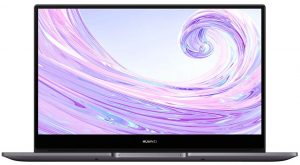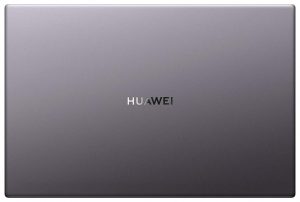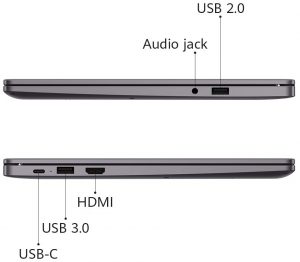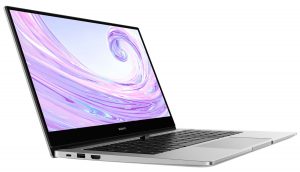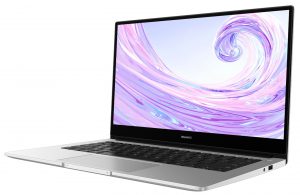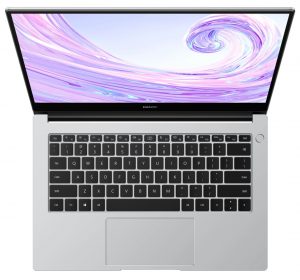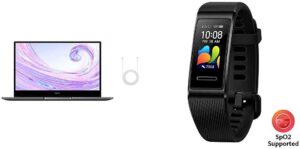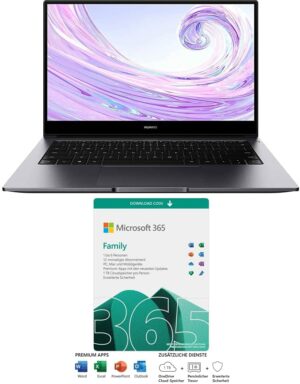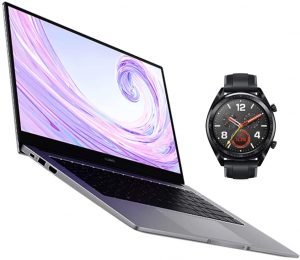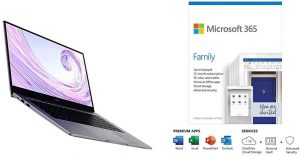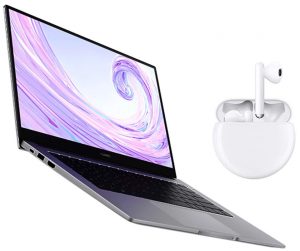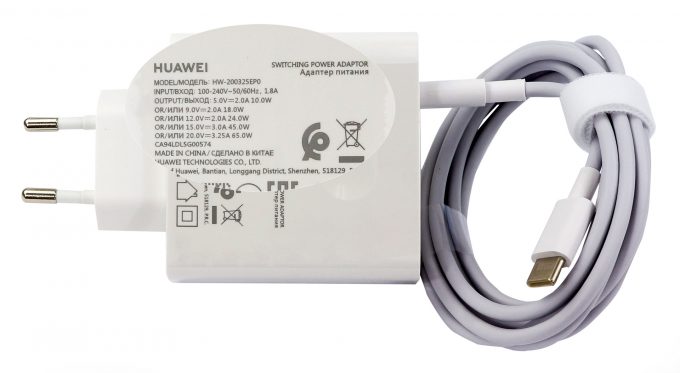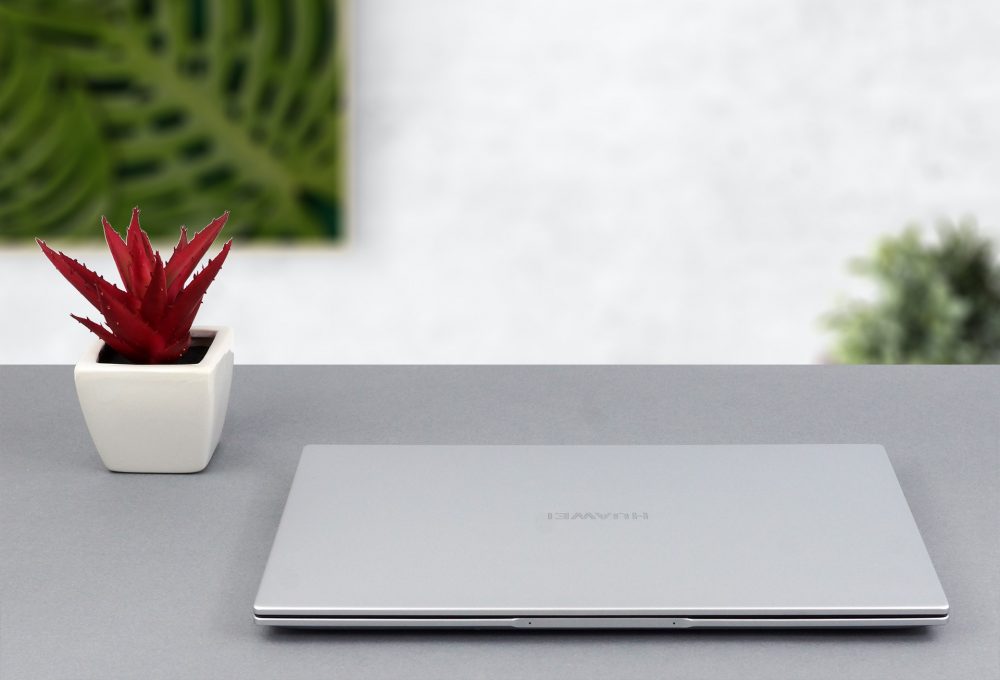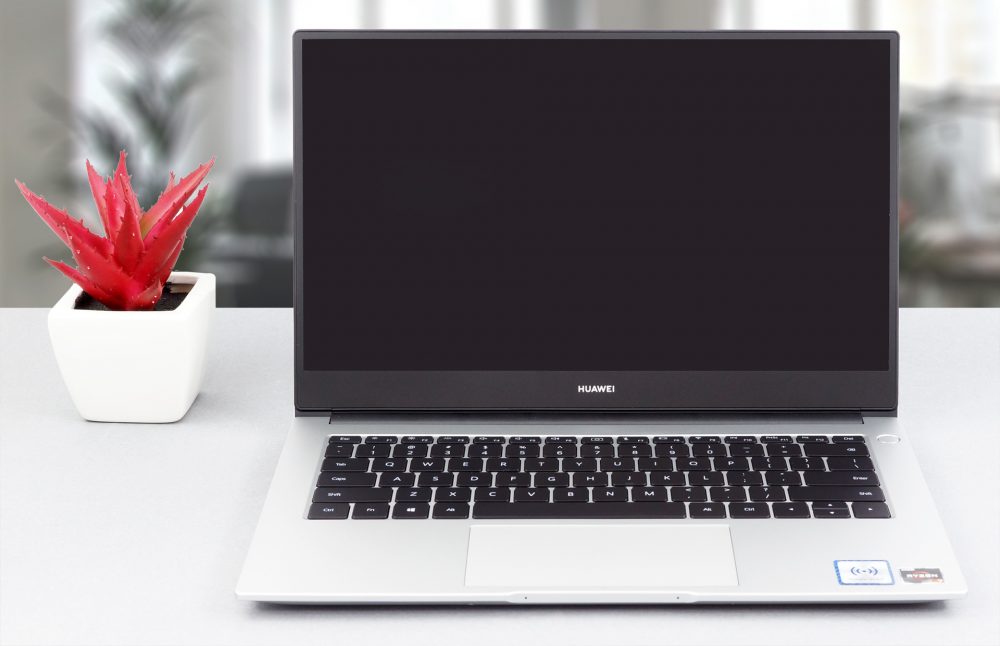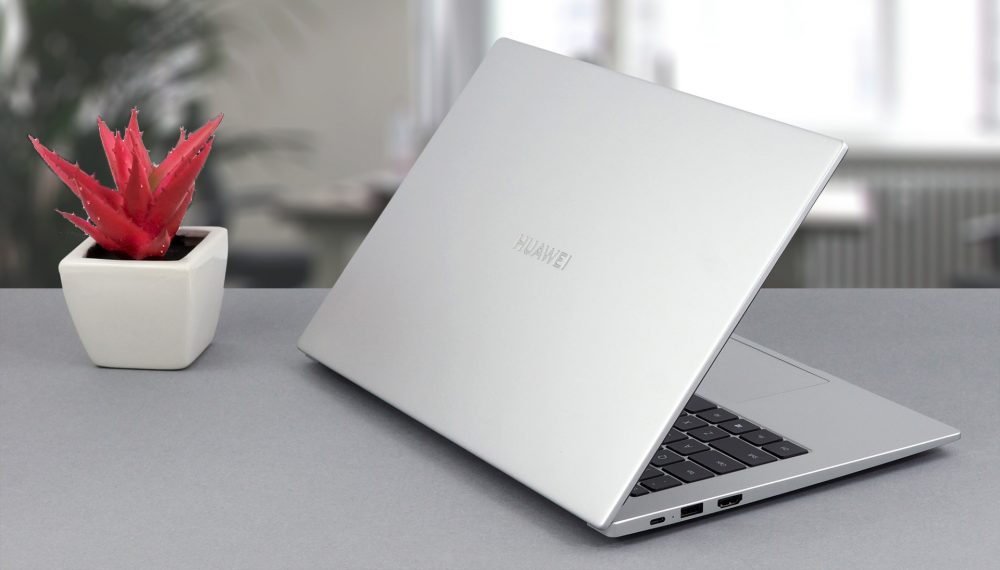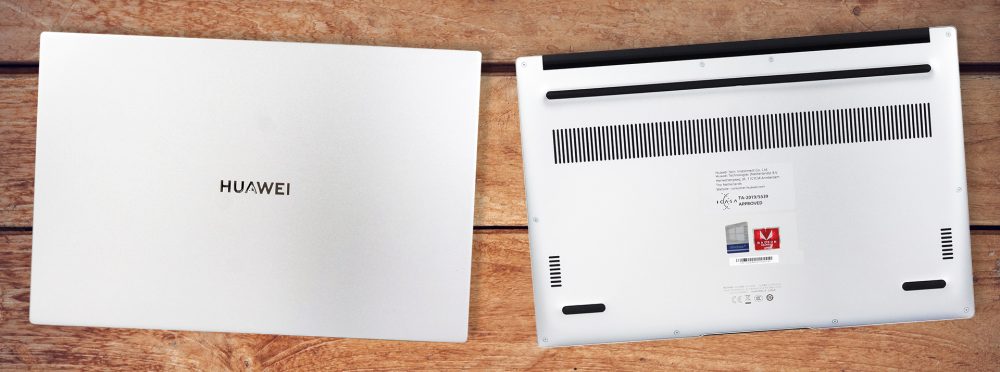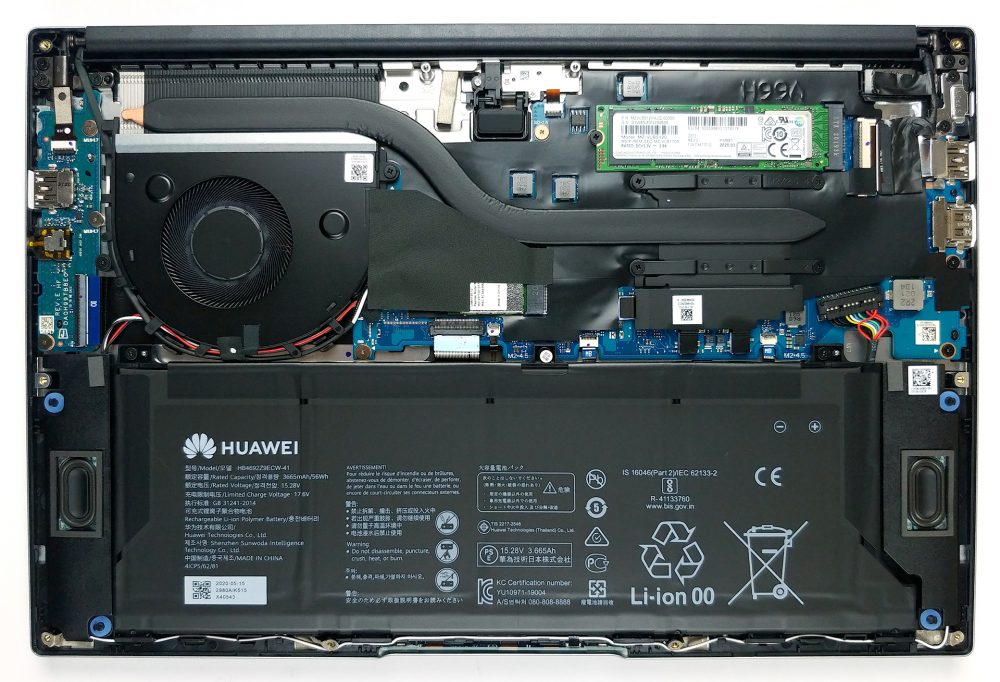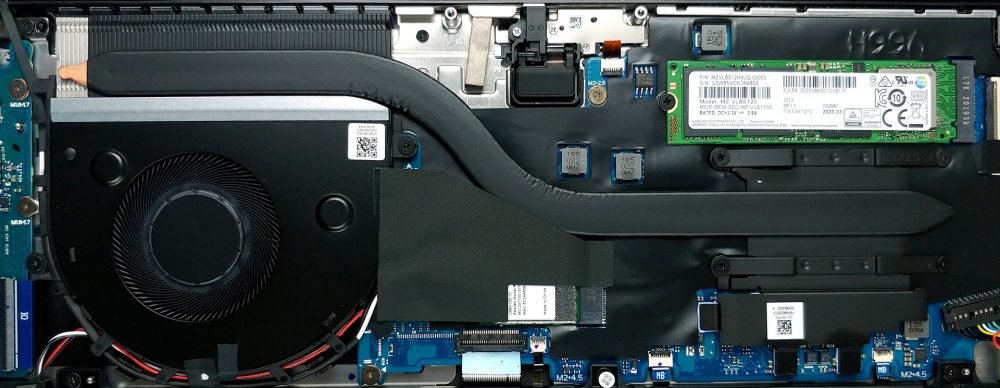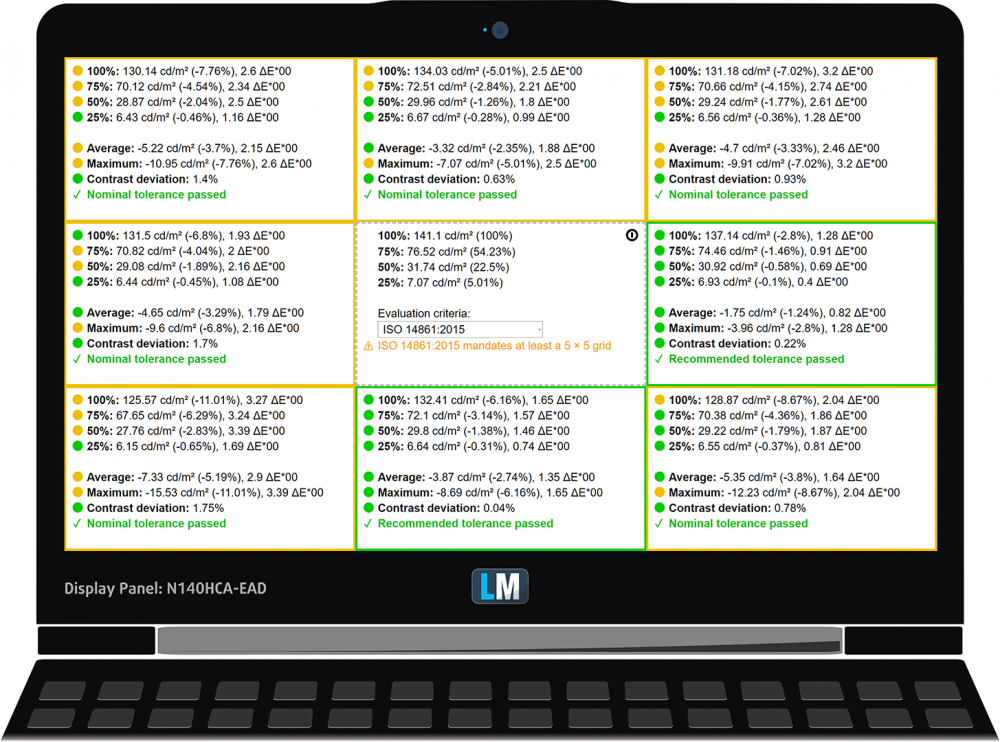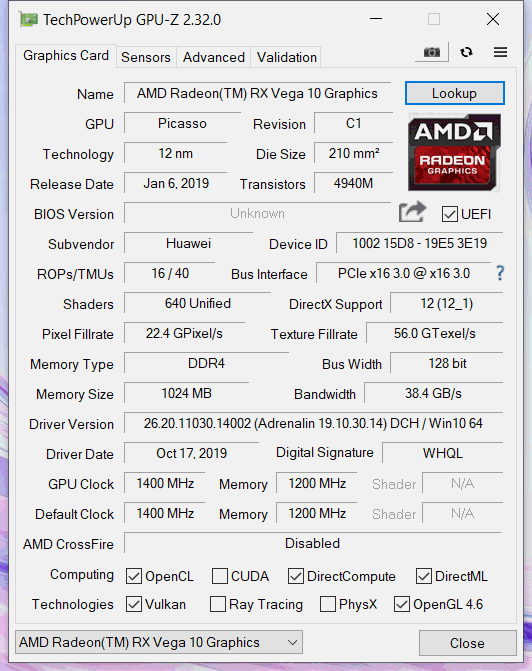Huawei MateBook D 14 (2020) review – a big effort from the Chinese company to conquer the mid-range market
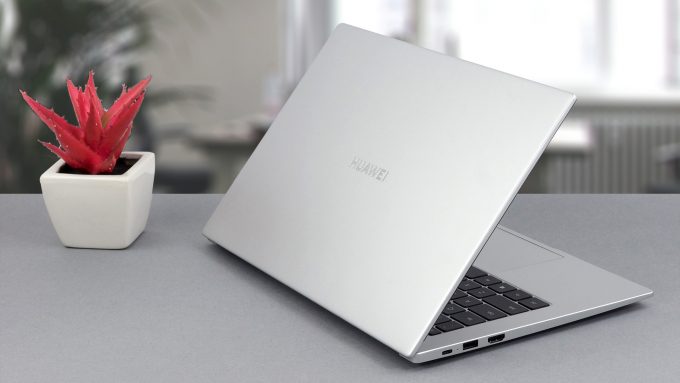 Finally, we are going to write a review, regarding a Huawei device. We’ve gotten many requests, but we were never able to snatch a MateBook before. With that said, the first Huawei notebook for us is the MateBook D 14 (2020) – a 14-inch machine, which boasts a 1080p IPS panel, and a cool feature like the Huawei Share, where you use the NFC of your Huawei smartphone to connect it to your notebook (in a similar fashion like the Apple devices).
Finally, we are going to write a review, regarding a Huawei device. We’ve gotten many requests, but we were never able to snatch a MateBook before. With that said, the first Huawei notebook for us is the MateBook D 14 (2020) – a 14-inch machine, which boasts a 1080p IPS panel, and a cool feature like the Huawei Share, where you use the NFC of your Huawei smartphone to connect it to your notebook (in a similar fashion like the Apple devices).
Also, the notebook is fairly inexpensive, especially given the hardware it packs. Our unit came with the Ryzen 7 3700U (although there are Ryzen 4000U and Intel variants), 8GB of RAM, and a 512GB NVMe SSD. This is actually a pretty good setup for office work, school, and even some light programming.
Now, let’s see what we found inside the box, and how well does the design fare in 2020.
You can check the prices and configurations in our Specs System: https://laptopmedia.com/series/huawei-matebook-d-14-2020/
Contents
Specs Sheet
- HDD/SSD
- up to 512GB SSD
- M.2 Slot
- 1x 2280 PCIe NVMe 3.0 x4 See photo
- RAM
- up to 16GB
- OS
- Windows 11 Home, Windows 10 Home, Windows 10 Pro
- Battery
- 56Wh, 4-cell, 56Wh
- Body material
- Plastic / Polycarbonate, Aluminum
- Dimensions
- 322.5 x 214.8 x 15.9 mm (12.70" x 8.46" x 0.63")
- Weight
- 1.38 kg (3 lbs)
- Ports and connectivity
- 1x USB Type-A
- 2.0
- 1x USB Type-A
- 3.2 Gen 1 (5 Gbps)
- 1x USB Type-C
- 3.2 Gen 1 (5 Gbps)
- HDMI
- Card reader
- Wi-Fi
- 802.11ac
- Bluetooth
- 5.0
- Audio jack
- 3.5 mm combo
- Features
- Fingerprint reader
- optional
- Web camera
- HD
- Backlit keyboard
- optional
- Microphone
- Speakers
- 2 Speakers
- Optical drive
- Security Lock slot
All Huawei MateBook D 14 (2020) configurations
What’s in the box?
Huawei ships this notebook with a neat 65W USB Type-C charging brick, which can fast charge your smartphone (no matter if it’s a Huawei or not). Also, you get some paper manuals and the laptop, itself, which is protected by an anti-static bag.
Design and construction
Here, we have a laptop, which is thin, light, and comfortable to handle. It weighs 1.38 kg and has a profile of 15.9mm. Its body is a combination of plastic and metal and comes in two colors – Mystic Silver and Space Gray. Since our unit was silver, we can tell you that fingerprints rarely stick to it, and it’s also pretty easy to clean. On the downside, you can see where some corners were cut in the build quality. When we twist the device, there is a strange gap that appears on one of the sides of the touchpad.
Also, its lid cannot be opened with a single hand, but thankfully, its structural integrity is far more superior, compared to the body. By the way, you will notice that the top and side bezels are extremely thin, and to the horror of all students, studying from home – there is no Webcam there.
This is because the camera is hidden beneath a dedicated key, located beneath the “F6” and “F7” keys. As soon, as you click it, it pops open and reveals the so-called “Nose” cam. Indeed, the location is bizarre, but at least there is a camera, right?
Other than that, the rest of the keyboard follows a MacBook layout. Also, Huawei seems to have employed a very short key travel. At least, the feedback is clicky. All-in-all the typing experience is good, but you will need some time to adapt.
Despite the earlier shenanigans, the touchpad is actually a pretty decent unit. It has a glass surface, which leads to admirable gliding. Last, but not least, there is the fingerprint reader, embedded into the Power button of the device. It is safe to say, that this is one of the fastest and most accurate units we’ve ever tested.
Unsurprisingly, the bottom panel is home to the speaker cutouts, as well as the ventilation grills. On the other side, the hot air escapes the chassis, through the vents on the back (in between the lid and the base).
Ports
On the left side, you will find a USB Type-C 3.2 (Gen. 1) port (used for charging and data transfer), a USB Type-A 3.2 (Gen. 1) port, and an HDMI connector. This means that the right side is only home to the USB Type-A 2.0 port, and an audio jack.
Disassembly, upgrade options, and maintenance
Getting inside of this device is as easy as undoing 10 Torx-head screws. After you do that, just pry the panel away with a plastic tool, starting from the back, and making your way around the device.
Inside, we can see that Huawei has taken care of the thermals. There is one rather long and thick heat pipe, that leads to a formidable heat spreader. Then, the heat is blown away by the fan. By the way, you can see where the pop-up camera hides, just where the heat pipe makes its first 90-degree turn.
As a typical ultrabook, the memory is soldered to the motherboard, and it comes in two variants – 8GB and 16GB. Thankfully, there is an M.2 NVMe slot for storage upgrades.
And what powers the notebook when you’re away of the plug? A 56Wh battery pack.
Display quality
Huawei MateBook D 14 (2020) has a Full HD IPS display, model number Chi Mei N140HAC-EAD (CNM1404). Its diagonal is 14″ (35.56 cm), and the resolution – 1920 х 1080. Additionally, the screen ratio is 16:9, the pixel density – 157 ppi, their pitch – 0.161 x 0.161 mm. The screen can be considered Retina when viewed from at least 56 cm (from this distance, the average human eye can’t see the individual pixels).
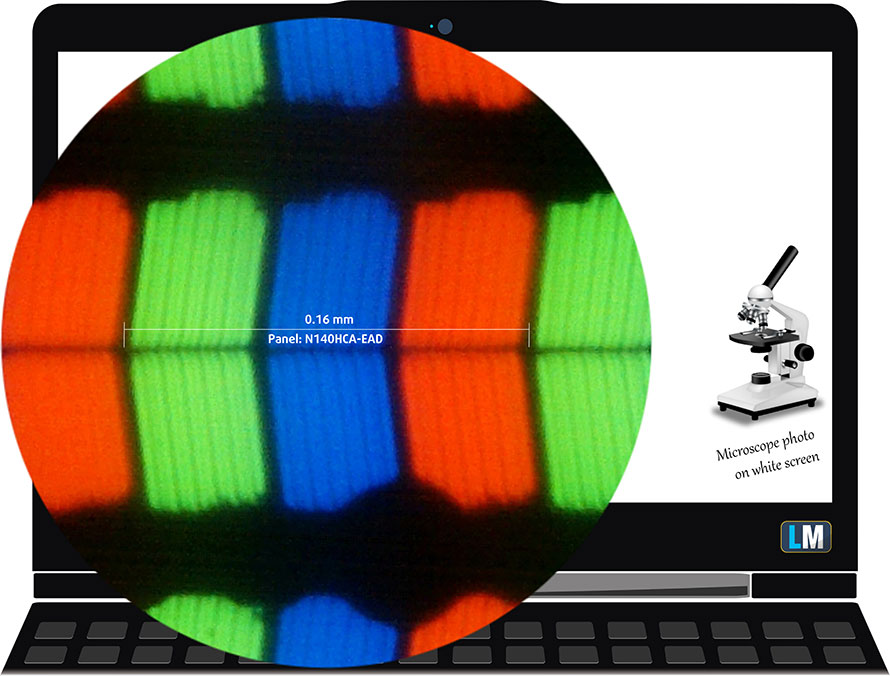
Its viewing angles are excellent. We have provided images at 45 degrees to evaluate quality.

The maximum measured brightness is 301 nits (cd/m2) in the middle of the screen and 281 nits (cd/m2) average across the surface with a maximum deviation of 11%. The Correlated Color Temperature on a white screen and at maximum brightness is 7360K (average) – colder than the 6500K optimum for sRGB. The average color temperature through the grey scale before profiling is 6590K.
In the illustration below you can see how the display performs from a uniformity perspective. The illustration below shows how matters are for operational brightness levels (approximately 140 nits) – in this particular case at 51% Brightness (White level = 141 cd/m2, Black level = 0.116 cd/m2).
Values of dE2000 over 4.0 should not occur, and this parameter is one of the first you should check if you intend to use the laptop for color-sensitive work (a maximum tolerance of 2.0 ). The contrast ratio is good – 1220:1 (1130:1 after profiling).
To make sure we are on the same page, we would like to give you a little introduction to the sRGB color gamut and the Adobe RGB. To start, there’s the CIE 1976 Uniform Chromaticity Diagram that represents the visible specter of colors by the human eye, giving you a better perception of the color gamut coverage and the color accuracy.
Inside the black triangle, you will see the standard color gamut (sRGB) that is being used by millions of people in HDTV and on the web. As for the Adobe RGB, this is used in professional cameras, monitors, etc for printing. Colors inside the black triangle are used by everyone and this is an essential part of the color quality and color accuracy of a mainstream notebook.
Still, we’ve included other color spaces like the famous DCI-P3 standard used by movie studios, as well as the digital UHD Rec.2020 standard. Rec.2020, however, is still a thing of the future and it’s difficult for today’s displays to cover that well. We’ve also included the so-called Michael Pointer gamut, or Pointer’s gamut, which represents the colors that naturally occur around us every day.
The yellow dotted line shows Huawei MateBook D 14 (2020)’s color gamut coverage.
Its display covers just 53% of the sRGB/ITU-R BT.709 (web/HDTV standard) in CIE1976.
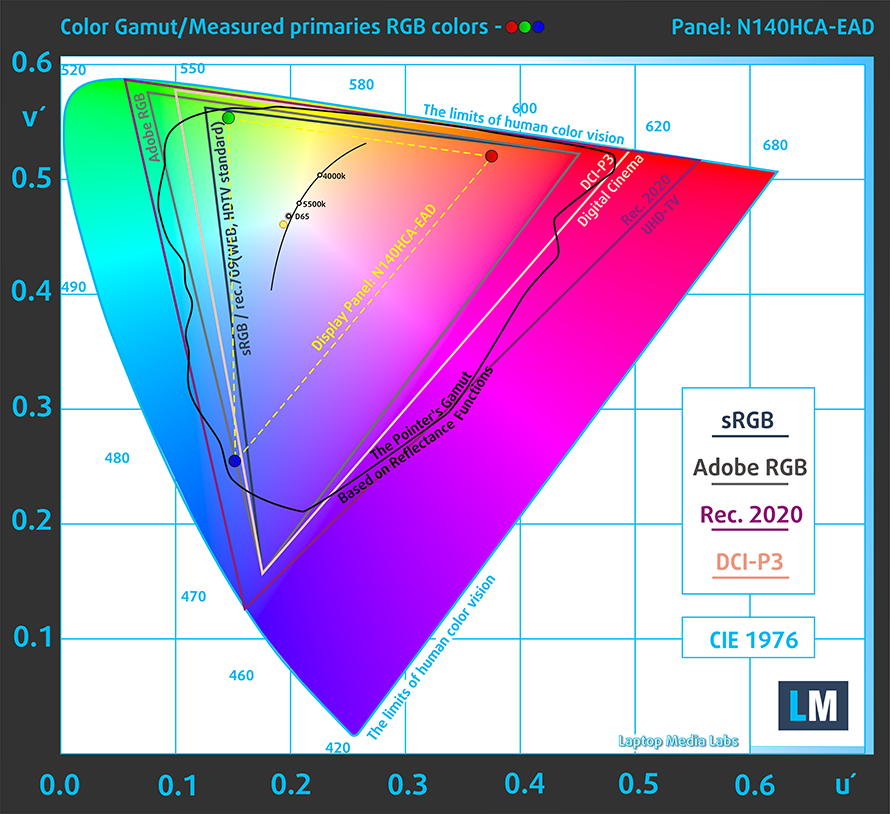
Our “Design and Gaming” profile delivers optimal color temperature (6500K) at 140 cd/m2 luminance and sRGB gamma mode.
We tested the accuracy of the display with 24 commonly used colors like light and dark human skin, blue sky, green grass, orange, etc. You can check out the results at factory condition and also, with the “Design and Gaming” profile.
Below you can compare the scores of Huawei MateBook D 14 (2020) with the default settings (left), and with the “Gaming and Web design” profile (right).
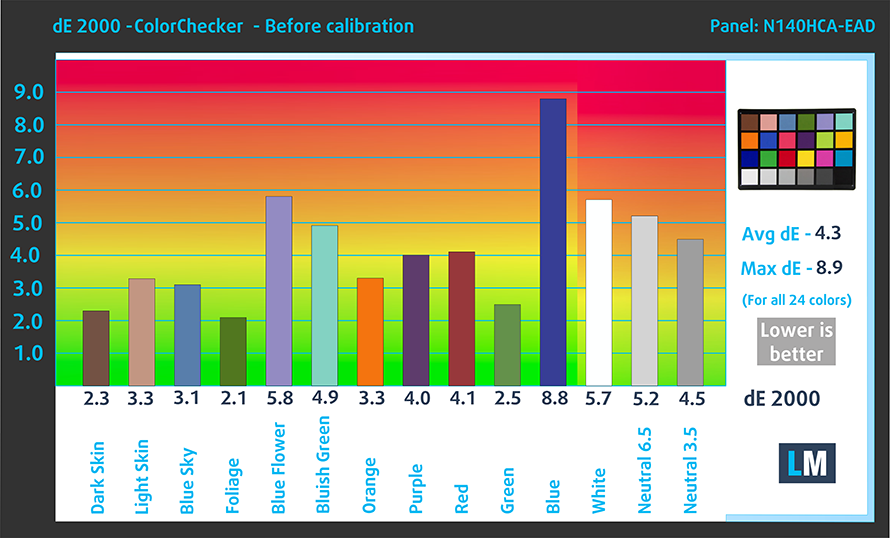
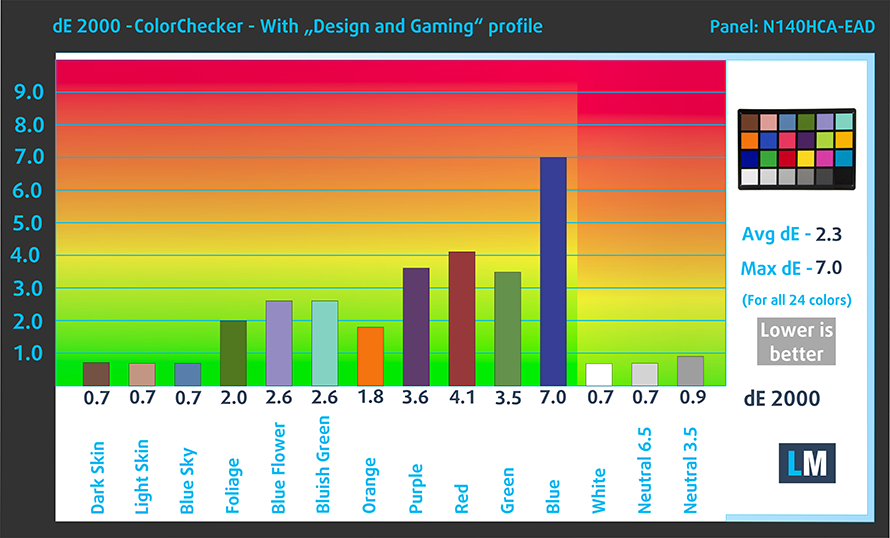
The next figure shows how well the display can reproduce dark parts of an image, which is essential when watching movies or playing games in low ambient light.
The left side of the image represents the display with stock settings, while the right one is with the “Gaming and Web Design” profile activated. On the horizontal axis, you will find the grayscale, and on the vertical axis – the luminance of the display. On the two graphs below you can easily check for yourself how your display handles the darkest nuances but keep in mind that this also depends on the settings of your current display, the calibration, the viewing angle, and the surrounding light conditions.
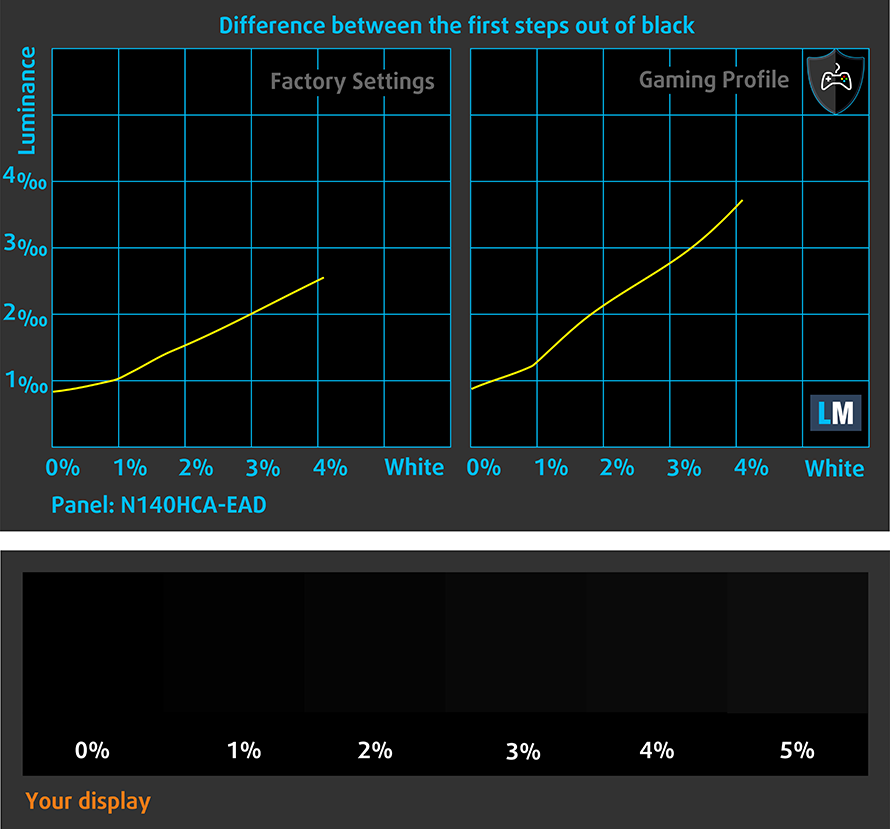
Response time (Gaming capabilities)
We test the reaction time of the pixels with the usual “black-to-white” and “white-to-black” method from 10% to 90% and vice versa.
We recorded Fall Time + Rise Time = 24 ms
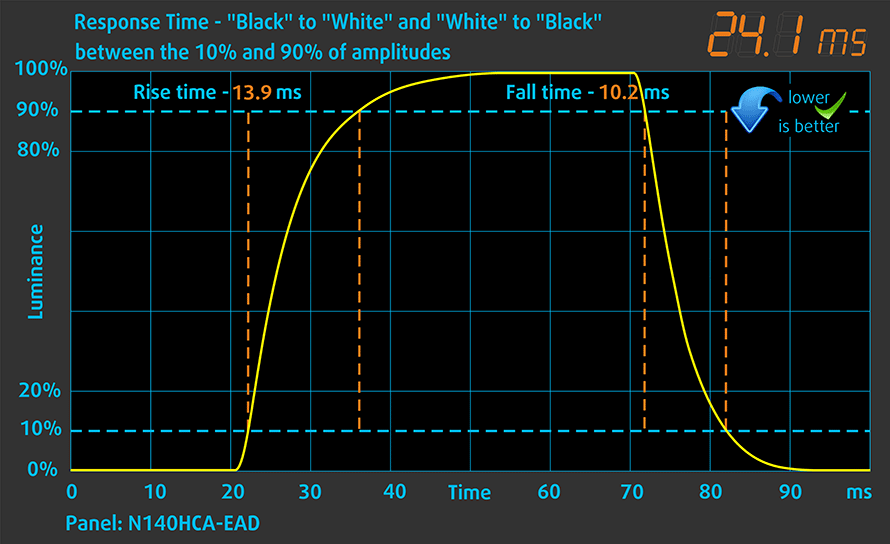
Health impact – PWM / Blue Light
PWM (Screen flickering)
Pulse-width modulation (PWM) is an easy way to control monitor brightness. When you lower the brightness, the light intensity of the backlight is not lowered, but instead turned off and on by the electronics with a frequency indistinguishable to the human eye. In these light impulses, the light/no-light time ratio varies, while brightness remains unchanged, which is harmful to your eyes. You can read more about that in our dedicated article on PWM.
Huawei MateBook D 14 (2020)’s display is using PWM to adjust the brightness up to 77 nits. After that its flicker-free. Moreover, the PWM it uses has a very high frequency, making the display comfortable for long hours of work and safe for your eyes in this aspect.
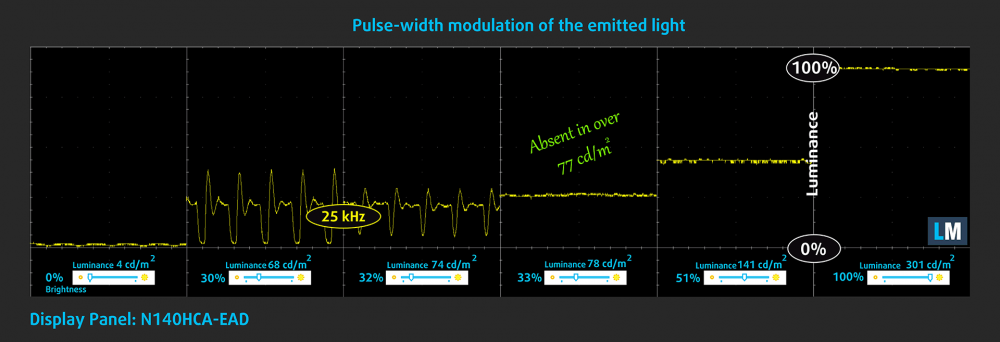
Blue light emissions
Installing our Health-Guard profile not only eliminates PWM but also reduces the harmful Blue Light emissions while keeping the colors of the screen perceptually accurate. If you’re not familiar with the Blue light, the TL;DR version is – emissions that negatively affect your eyes, skin, and your whole body. You can find more information about that in our dedicated article on Blue Light.
Conclusions
Huawei MateBook D 14 (2020)’s IPS panel has comfortable viewing angles, good contrast ratio, Full HD resolution, and it uses PWM only in low-brightness scenarios (up to 77 nits) and with a very high frequency, which is rather comfortable to use. Sadly, it only covers 53% of the sRGB color gamut.
Buy our profiles
Since our profiles are tailored for each display model, this article and its respective profile package are meant for Huawei MateBook D 14 (2020) configurations with 14.0″ Chi Mei N140HCA-EAD (CMN1404) (FHD, 1920 × 1080) IPS panel.
*Should you have problems with downloading the purchased file, try using a different browser to open the link you’ll receive via e-mail. If the download target is a .php file instead of an archive, change the file extension to .zip or contact us at [email protected].
Read more about the profiles HERE.
In addition to receiving efficient and health-friendly profiles, by buying LaptopMedia's products you also support the development of our labs, where we test devices in order to produce the most objective reviews possible.

Office Work
Office Work should be used mostly by users who spend most of the time looking at pieces of text, tables or just surfing. This profile aims to deliver better distinctness and clarity by keeping a flat gamma curve (2.20), native color temperature and perceptually accurate colors.

Design and Gaming
This profile is aimed at designers who work with colors professionally, and for games and movies as well. Design and Gaming takes display panels to their limits, making them as accurate as possible in the sRGB IEC61966-2-1 standard for Web and HDTV, at white point D65.

Health-Guard
Health-Guard eliminates the harmful Pulse-Width Modulation (PWM) and reduces the negative Blue Light which affects our eyes and body. Since it’s custom tailored for every panel, it manages to keep the colors perceptually accurate. Health-Guard simulates paper so the pressure on the eyes is greatly reduced.
Get all 3 profiles with 33% discount
Sound
Huawei MateBook D 14 (2020)’s speakers produce a crisp and relatively loud sound with good quality. Moreover, its low, mid, and high tones are clear of deviations.
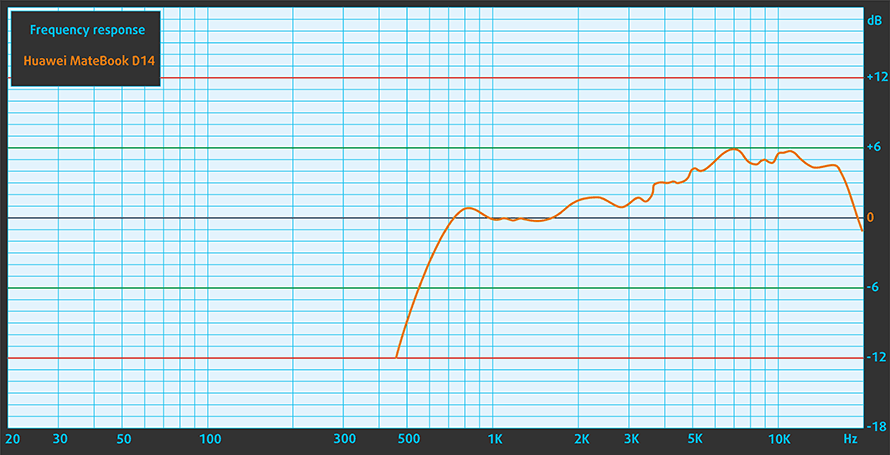
Drivers
All of the drivers and utilities for this notebook can be downloaded from here: https://consumer.huawei.com/en/support/laptops/matebook-d-14-amd/
Battery
Now, we conduct the battery tests with Windows Better performance setting turned on, screen brightness adjusted to 120 nits, and all other programs turned off except for the one we are testing the notebook with. This notebook’s 56Wh battery can deliver 13 hours and 53 minutes of Web browsing and 10 hours and 25 minutes of video playback.
In order to simulate real-life conditions, we used our own script for automatic web browsing through over 70 websites.
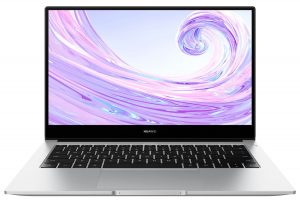
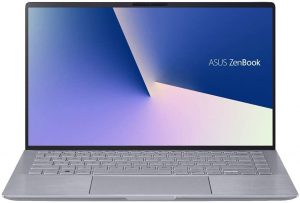
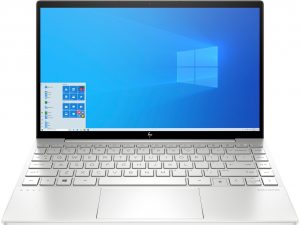
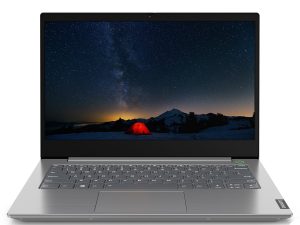
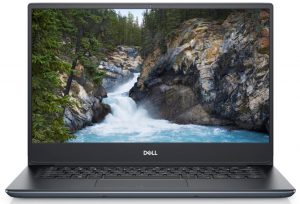
For every test like this, we use the same video in HD.





CPU options
Depending on the region you live, the processors of choice would be either the Ryzen 5 3500U/Ryzen 7 3700U or the Ryzen 5 4500U/Ryzen 7 4700U. The former duo is a quad-core, eight-thread combo, while the latter two have six cores and eight cores, respectively. Additionally, some units will ship with Intel Comet Lake-U CPUs.
Results are from the Cinebench 20 CPU test (the higher the score, the better)
Results are from our Photoshop benchmark test (the lower the score, the better)
GPU options
As far as we know, regardless of the processor, if you get an AMD model, it will come with integrated graphics only. On the other side, the Intel versions come with either the Intel UHD Graphics or the NVIDIA GeForce MX250.
Results are from the 3DMark: Time Spy (Graphics) benchmark (higher the score, the better)
Results are from the 3DMark: Fire Strike (Graphics) benchmark (higher the score, the better)
Results are from the Unigine Superposition benchmark (higher the score, the better)
Gaming tests

| CS:GO | HD 1080p, Low (Check settings) | HD 1080p, Medium (Check settings) | HD 1080p, MAX (Check settings) |
|---|---|---|---|
| Average FPS | 70 fps | 57 fps | 41 fps |

| DOTA 2 | HD 1080p, Low (Check settings) | HD 1080p, Normal (Check settings) | HD 1080p, High (Check settings) |
|---|---|---|---|
| Average FPS | 83 fps | 57 fps | 32 fps |
Temperatures and comfort
Max CPU load
In this test we use 100% on the CPU cores, monitoring their frequencies and chip temperature. The first column shows a computer’s reaction to a short load (2-10 seconds), the second column simulates a serious task (between 15 and 30 seconds), and the third column is a good indicator of how good the laptop is for long loads such as video rendering.
Average core frequency (base frequency + X); CPU temp.
| AMD Ryzen 7 3700U (15W TDP) | 0:02 – 0:10 sec | 0:15 – 0:30 sec | 10:00 – 15:00 min |
|---|---|---|---|
| Huawei MateBook D14 | 3.16 GHz (B+37%) @ 55°C | 3.18 GHz (B+38%) @ 65°C | 3.16 GHz (B+37%) @ 70°C |
| ASUS VivoBook 15 F512 (X512) | 3.10 GHz (B+35%) @ 65°C | 3.09 GHz (B+34%) @ 80°C | 2.39 GHz (B+9%) @ 68°C |
Here, we saw a very well-calculated cooling solution. It never runs too loud, nor too hot. Even when we threw the excessive workloads of Prime95 at it.
Comfort during full load
As we said, the notebook doesn’t produce a lot of noise, and its keyboard is slightly warmer than 41C.
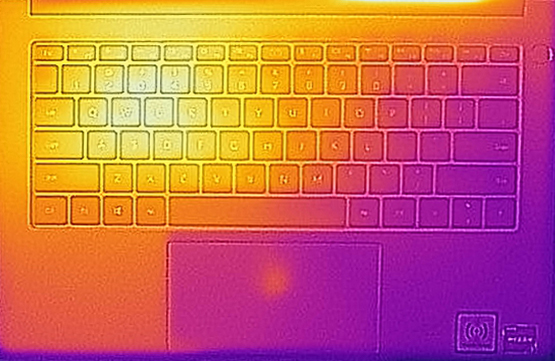
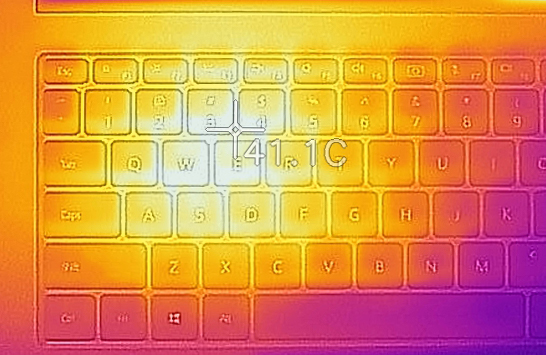
Verdict
All in all, this might be one of the best notebooks in its class. Keep in mind that we tested the model, equipped with Ryzen 3000U processors, so if you manage to lay your hands on a Ryzen 4000U, and it costs something in the same neighborhood as this unit, don’t hesitate.
Not only does it have relatively potent hardware, which ensures fast execution of pretty much all daily tasks, including office work, and even some light gaming, but its battery life lasts for about 14 hours of Web browsing and 10 hours and a half of video playback. Also, it comes with a super-fast fingerprint sensor and a cool feature called “Huawei Share”, where you can effortlessly connect to your Huawei smartphone, by touching your device to the designated spot of the laptop.
Huawei MateBook D 14 (2020)’s IPS panel has comfortable viewing angles, good contrast ratio, Full HD resolution, and it uses PWM only in low-brightness scenarios (up to 77 nits) and with a very high frequency, which is rather comfortable to use. Sadly, it only covers 53% of the sRGB color gamut.
Also, you won’t be able to upgrade its memory, as all of it is soldered to the motherboard. So, our advice would be (if you’re using this device for work), get the 16GB version. And what is even more frustrating than the lack of a simple upgrade – the camera placement! Man, we were very upset with the Web camera location of the Lenovo Legion Y530 and the Dell XPS 13 9370, but this goes down even further (pun intended). It is located on the keyboard, which makes for the ultimate booger photography.
That’s pretty much it. Honestly, we were surprised by the quality this notebook offers for such a low price tag, but there is definitely room for improvement, especially regarding the design.
Pros
- Snappy experience
- PCIe x4 support and a fingerprint reader on board
- Doesn’t use aggressive PWM for brightness adjustment (BOE NV140FHM-N63)
- Great battery life
- ErgoLift hinge and NumberPad 2.0 support
Cons
- RAM is soldered to the motherboard
- Terrible camera location
- Covers 53% of the sRGB color gamut (BOE NV140FHM-N63)
You can check the prices and configurations in our Specs System: https://laptopmedia.com/series/huawei-matebook-d-14-2020/
